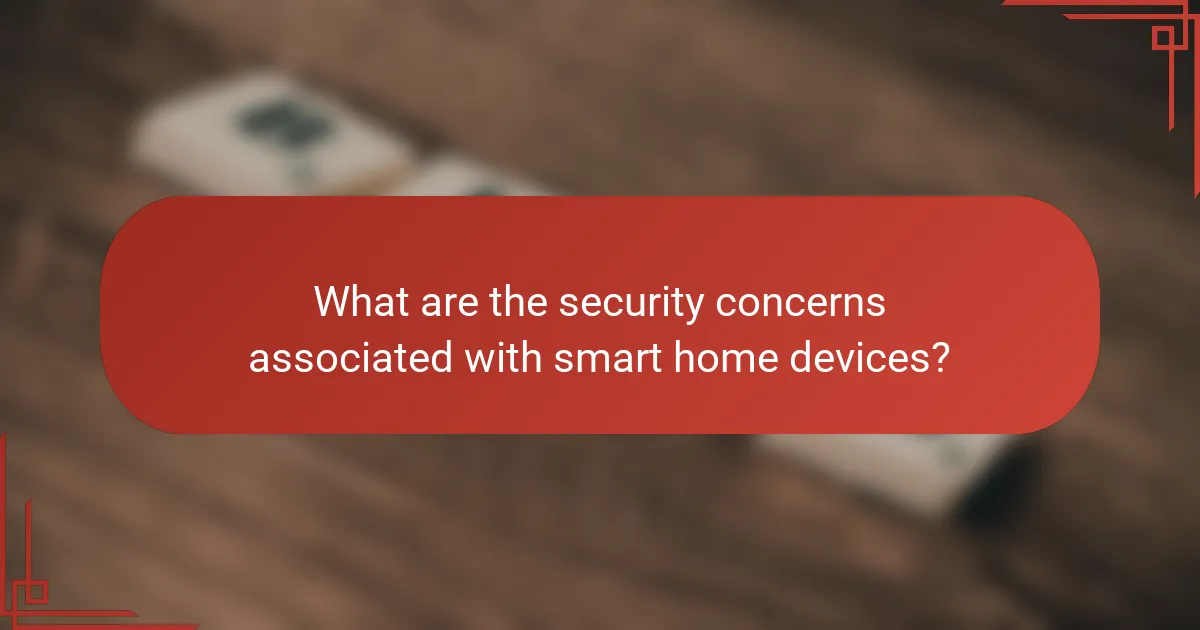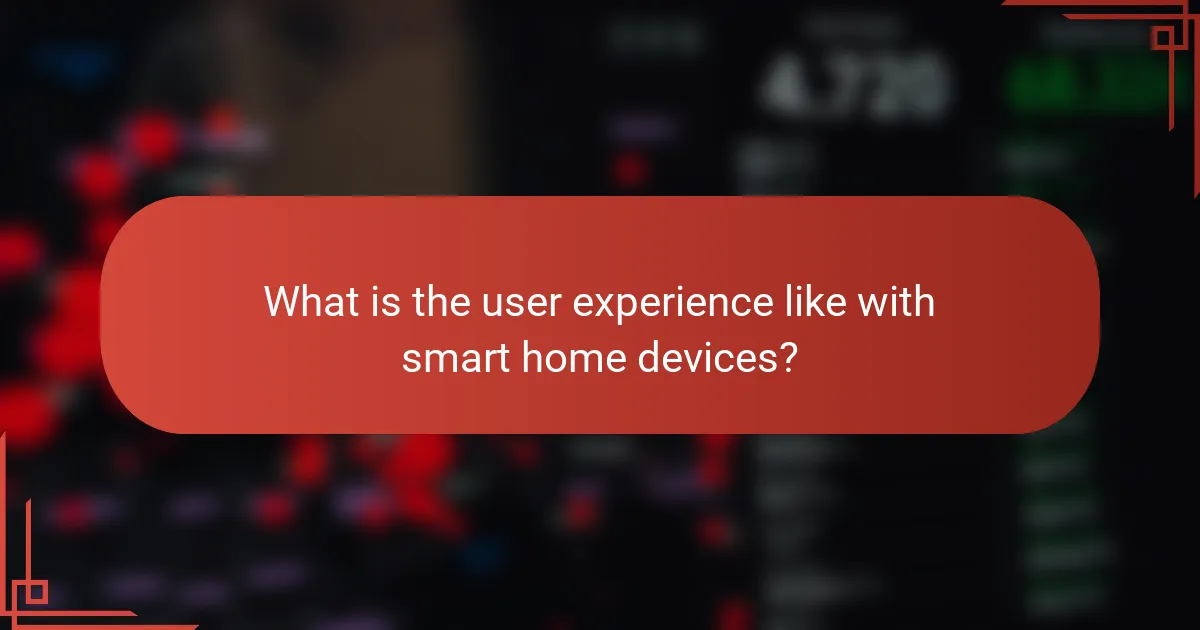Smart home devices are internet-connected electronic gadgets that can be controlled remotely, including smart lights, thermostats, cameras, and speakers. This article explores the evolution of these devices from standalone products to integrated systems facilitated by smart hubs, highlighting advancements such as voice control and automation. It also addresses significant security concerns, noting that many smart home devices have known vulnerabilities and can be targets for cyberattacks. Additionally, the article examines user experiences, emphasizing the balance between convenience and security, as well as the challenges some users face with setup and connectivity. Overall, it provides a comprehensive overview of the current state of the smart home market and its implications for consumers.

What are smart home devices and how have they evolved over time?
Smart home devices are electronic gadgets that connect to the internet and can be controlled remotely. They include items like smart lights, thermostats, cameras, and speakers. Initially, these devices were standalone products with limited functionality. Over time, they have evolved to integrate seamlessly with each other and broader home systems.
The introduction of smart hubs facilitated this integration, allowing devices from different manufacturers to work together. As technology advanced, features like voice control and automation became standard. The rise of artificial intelligence further enhanced user experience by enabling predictive functionalities.
According to a report by Statista, the global smart home market is projected to reach $174 billion by 2025. This growth reflects the increasing consumer demand for convenience, energy efficiency, and security. Overall, smart home devices have transitioned from basic remote controls to sophisticated systems that enhance everyday living.
What are the key milestones in the evolution of smart home devices?
The key milestones in the evolution of smart home devices include the introduction of the first programmable thermostat in 1985. This device allowed users to set heating schedules remotely. In the late 1990s, the first home automation systems emerged, integrating various devices for centralized control. The launch of the first smart light bulb in 2012 marked a significant advancement in user-friendly smart technology. In 2014, the introduction of smart speakers with voice assistants provided a new interface for controlling smart devices. The rise of the Internet of Things (IoT) in the mid-2010s further accelerated smart home adoption, connecting devices seamlessly. By 2020, security concerns led to enhanced features in smart devices, prioritizing user privacy and data protection. Each of these milestones contributed to the growing complexity and functionality of smart home ecosystems.
How did early smart home technologies pave the way for modern devices?
Early smart home technologies introduced foundational concepts that shaped modern devices. These technologies began with basic automation systems in the 1970s, such as programmable thermostats. They allowed users to control home environments remotely, laying the groundwork for connectivity.
In the 1980s, the X10 protocol enabled communication between devices over power lines. This development facilitated the automation of lighting and appliances. The rise of the internet in the 1990s further advanced smart home technology. It enabled remote access and control, leading to the development of early smart hubs.
By the early 2000s, wireless technologies like Wi-Fi and Bluetooth became prevalent. These advancements allowed for seamless integration of devices within homes. Smart home ecosystems began to emerge, paving the way for modern smart speakers and home assistants.
Today’s smart home devices leverage these early innovations. They offer enhanced functionality, user-friendly interfaces, and improved security features. The evolution from basic automation to sophisticated interconnected systems illustrates the significant impact of early smart home technologies.
What technological advancements have significantly impacted smart home devices?
Technological advancements that have significantly impacted smart home devices include IoT (Internet of Things) connectivity, AI (Artificial Intelligence), and voice recognition technology. IoT connectivity allows devices to communicate with each other and the internet. This integration enables remote control and automation of home systems. AI enhances smart devices by enabling learning and predictive capabilities. It allows devices to adapt to user preferences over time. Voice recognition technology facilitates hands-free operation of smart devices. This advancement improves user convenience and accessibility. According to a report by Statista, the global smart home market is projected to reach $174 billion by 2025, demonstrating the impact of these technologies.
How do smart home devices integrate with each other?
Smart home devices integrate with each other through communication protocols and platforms. These protocols include Wi-Fi, Zigbee, and Z-Wave, allowing devices to exchange data. Integration often occurs via a central hub or smart assistant, like Amazon Alexa or Google Assistant. These hubs facilitate commands and automation routines across devices. For example, a smart thermostat can adjust the temperature when a smart door lock is engaged. Many devices are designed to be compatible with multiple platforms, enhancing user flexibility. The interoperability of devices improves user experience by enabling seamless control. Research shows that 70% of smart home users prefer devices that work together easily.
What is the role of smart home hubs in device integration?
Smart home hubs serve as central controllers for integrating various smart devices within a home. They facilitate communication between devices that may use different protocols. Hubs enable users to manage devices from a single interface or app. They support automation by allowing users to create routines that trigger multiple devices simultaneously. Additionally, smart home hubs enhance interoperability among devices from different manufacturers. This integration streamlines user experience and improves functionality. For instance, a hub can connect a smart thermostat, lights, and security cameras to work in unison. According to research by Parks Associates, over 70% of smart home device owners use a hub for better control and management.
How do different protocols affect integration among devices?
Different protocols significantly impact the integration of devices by determining how they communicate. Protocols set the rules for data exchange between devices. For example, Wi-Fi allows high-speed data transfer but consumes more power. Zigbee, on the other hand, uses less power and is suitable for battery-operated devices. Each protocol has unique attributes affecting compatibility. Devices using the same protocol can easily integrate and share functionalities. However, devices using different protocols may require additional hubs or bridges for integration. This can complicate user experience and increase costs. The choice of protocol influences the overall efficiency and effectiveness of smart home ecosystems.

What are the security concerns associated with smart home devices?
Smart home devices face several security concerns. These devices often collect personal data, making them targets for cyberattacks. Weak or default passwords can lead to unauthorized access. Insecure networks may allow hackers to infiltrate connected devices. Malware can be introduced through compromised software updates. Data breaches can expose sensitive information to malicious actors. Additionally, privacy issues arise when devices continuously monitor user behavior. According to a 2021 study by the Cybersecurity & Infrastructure Security Agency, 70% of smart home devices have known vulnerabilities. This highlights the critical need for enhanced security measures in smart home technology.
What types of security vulnerabilities are common in smart home devices?
Common security vulnerabilities in smart home devices include weak passwords, outdated firmware, and insecure network configurations. Weak passwords can be easily guessed or cracked, allowing unauthorized access. Outdated firmware often contains unpatched security flaws, making devices susceptible to attacks. Insecure network configurations, such as open Wi-Fi networks, expose devices to unauthorized users. Additionally, many devices lack encryption, making data transmitted between devices and servers vulnerable to interception. These vulnerabilities can lead to privacy breaches and unauthorized control over smart home systems.
How can unauthorized access occur in smart home systems?
Unauthorized access in smart home systems can occur through various vulnerabilities. Weak passwords are a primary entry point for attackers. Many users fail to change default passwords, making systems easy targets. Outdated firmware can also leave devices exposed to known exploits. Unsecured Wi-Fi networks allow unauthorized users to intercept communications. Additionally, poorly configured settings can enable access to sensitive data. Phishing attacks can trick users into revealing credentials. Third-party applications may introduce security risks if not properly vetted. These factors collectively increase the likelihood of unauthorized access in smart home environments.
What are the implications of data privacy for smart home users?
Data privacy implications for smart home users include potential unauthorized access to personal information. Smart home devices often collect sensitive data, such as user habits and preferences. This data can be vulnerable to hacking, leading to identity theft or privacy breaches. For instance, a study by the University of California found that 70% of smart home devices had significant security flaws. Users may also face risks from third-party data sharing, where companies sell user data without consent. Additionally, lack of transparency in data handling can lead to distrust among users. Ensuring robust security measures and user control over data is essential for mitigating these risks.
How can users enhance the security of their smart home devices?
Users can enhance the security of their smart home devices by implementing strong passwords and enabling two-factor authentication. Strong passwords should be complex and unique for each device. Two-factor authentication adds an extra layer of security by requiring a second form of verification. Regularly updating device firmware is crucial as manufacturers release security patches. Users should also disable features like Universal Plug and Play (UPnP) which can expose devices to vulnerabilities. Secure home Wi-Fi networks with strong encryption protocols, such as WPA3, to prevent unauthorized access. Finally, users can monitor device activity and logs to detect any unusual behavior. These practices significantly reduce the risk of unauthorized access and enhance overall security.
What best practices should users follow to secure their devices?
Users should follow several best practices to secure their devices. First, they should use strong, unique passwords for each device. A strong password typically includes a mix of letters, numbers, and symbols. Second, users should enable two-factor authentication whenever possible. This adds an extra layer of security beyond just the password. Third, keeping device firmware and software updated is crucial. Regular updates often include security patches that protect against vulnerabilities. Fourth, users should disable features like remote access if not needed. This reduces potential entry points for attackers. Fifth, they should use a secure Wi-Fi network and change the default router settings. A secure network helps prevent unauthorized access. Lastly, users should regularly review device permissions and settings. This ensures only necessary access is granted. Following these practices significantly enhances device security.
What security features should users look for when purchasing smart home devices?
Users should look for strong encryption and secure authentication when purchasing smart home devices. Encryption protects data transmitted between devices and the cloud. Secure authentication, such as two-factor authentication, adds an extra layer of security. Regular firmware updates are crucial for addressing vulnerabilities. Users should also seek devices that comply with security standards like WPA3 for Wi-Fi. Additionally, privacy policies should be transparent regarding data usage. Devices with customizable privacy settings allow users to control their information. According to a report by the Consumer Technology Association, 70% of consumers prioritize security features in smart home devices.

What is the user experience like with smart home devices?
User experience with smart home devices is generally positive, characterized by convenience and automation. Users appreciate the ability to control devices remotely via smartphone apps. Many devices offer voice control, enhancing accessibility and ease of use. Integration with various platforms, such as Amazon Alexa and Google Assistant, improves functionality.
However, some users report challenges with setup and connectivity issues. Security concerns also affect user confidence, as vulnerabilities can lead to unauthorized access. According to a 2021 survey by Statista, 70% of smart home device users value convenience over security. Overall, the user experience is shaped by a balance of benefits and challenges.
How do smart home devices improve user convenience?
Smart home devices enhance user convenience by automating daily tasks and providing remote control capabilities. Users can manage lighting, temperature, and security systems from their smartphones. This reduces the need for manual adjustments. For instance, smart thermostats learn user preferences and optimize energy use. Voice-activated assistants allow hands-free operation for various functions. Integration with other devices creates a seamless experience. According to a study by the Consumer Technology Association, 70% of smart home device users report increased convenience in their daily routines.
What functionalities do users find most beneficial in smart home devices?
Users find automation, remote control, and energy management functionalities most beneficial in smart home devices. Automation allows users to schedule tasks, enhancing convenience. Remote control enables users to manage devices from anywhere via smartphone apps. Energy management functionalities help users monitor and reduce energy consumption, leading to cost savings. Security features, such as surveillance cameras and smart locks, provide peace of mind by enhancing home safety. A survey by Statista in 2022 indicated that 70% of smart home device users prioritize convenience and security in their choices.
How do users interact with their smart home devices?
Users interact with their smart home devices through various methods. Common interactions include voice commands, mobile applications, and automation routines. Voice assistants like Amazon Alexa and Google Assistant allow users to control devices hands-free. Mobile apps provide a graphical interface for managing settings and monitoring device status. Users can create automation routines to schedule actions, such as turning lights on at sunset. Additionally, some devices offer physical buttons for manual control. Research indicates that 70% of smart home device users prefer voice commands for convenience (Statista, 2023). This highlights the growing trend of voice interaction in smart home technology.
What challenges do users face in adopting smart home technology?
Users face several challenges in adopting smart home technology. One major challenge is the complexity of installation and setup. Many devices require technical knowledge that average users may lack. Another challenge is the integration of various devices from different manufacturers. Compatibility issues can arise, making it difficult to create a cohesive smart home system. Security concerns also pose a significant barrier. Users worry about potential hacking and data breaches associated with connected devices. Additionally, the cost of smart home technology can be prohibitive for some consumers. High initial investment and ongoing maintenance expenses can deter adoption. Lastly, users often experience a steep learning curve when navigating new technology. This can lead to frustration and reluctance to fully utilize the devices.
What common issues do users encounter with installation and setup?
Users commonly encounter connectivity issues during installation and setup of smart home devices. These issues often arise due to incompatible Wi-Fi networks or weak signals. Another frequent problem is difficulty in syncing devices with mobile applications. Users may also face challenges related to device compatibility with existing smart home ecosystems. Additionally, firmware updates can complicate the setup process. Misunderstanding setup instructions is another common hurdle. Users often report issues with power supply or battery requirements. Lastly, users may encounter security prompts that delay or hinder the installation process.
How do users perceive the learning curve associated with smart home systems?
Users often perceive the learning curve of smart home systems as steep and challenging. Many users report initial difficulties in setup and integration of devices. This complexity can lead to frustration, particularly for those who are not tech-savvy. Research indicates that around 60% of users experience confusion during the initial phases of use. Users often struggle with navigation through various apps and interfaces. Additionally, inconsistent user experiences across different brands contribute to the perception of a steep learning curve. However, many users eventually adapt, citing improved convenience and efficiency as benefits of mastery.
What are some practical tips for optimizing the user experience with smart home devices?
To optimize the user experience with smart home devices, ensure seamless integration among devices. Use a unified app to control all devices for convenience. Regularly update device firmware to enhance security and functionality. Customize settings to match personal preferences for better usability. Utilize voice commands for hands-free operation, increasing accessibility. Place devices strategically for optimal connectivity and performance. Regularly review and adjust automation settings to improve efficiency. Lastly, consider user feedback to make informed adjustments and improvements.
Smart home devices are internet-connected gadgets that can be remotely controlled, including smart lights, thermostats, and cameras. This article explores their evolution from standalone products to integrated systems enhanced by AI and IoT, highlighting key milestones and technological advancements. It addresses the integration of devices through smart hubs and various communication protocols, as well as the security concerns associated with these technologies. Additionally, it discusses user experience, including convenience, challenges in adoption, and best practices for optimizing security and functionality in smart home environments.


